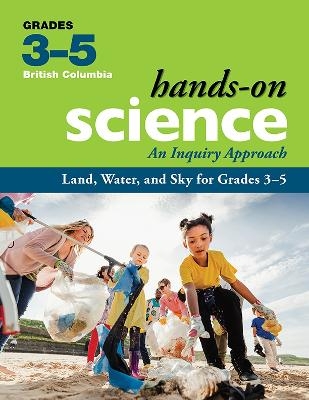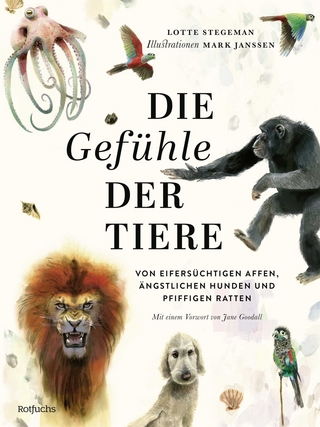
Land, Water, and Sky for Grades 3-5
Portage & Main Press (Verlag)
978-1-55379-880-4 (ISBN)
- Titel z.Zt. nicht lieferbar
- Versandkostenfrei
- Auch auf Rechnung
- Artikel merken
emphasizes Core Competencies, so students engage in deeper and lifelong learning
develops Curricular Competencies as students explore science through hands-on activities
fosters a deep understanding of the Big Ideas in science
Using proven Hands-On features, Land, Water, and Sky contains information and materials for both teachers and students including: Curricular Competencies correlation charts; background information on the science topics; complete, easy-to-follow lesson plans; reproducible student materials; and materials lists.
Innovative new elements have been developed specifically for the new curriculum:
a multi-age approach
a five-part instructional process—Engage, Explore, Expand, Embed, Enhance
an emphasis on technology, sustainability, and personalized learning
a fully developed assessment plan for summative, formative, and student self-assessment
a focus on real-life Applied Design, Skills, and Technologies
learning centres that focus on multiple intelligences and universal design for learning (UDL)
place-based learning activities, Makerspace centres, and Loose Parts
In Land, Water, and Sky students investigate characteristics of the land, water, and sky. Core Competencies and Curricular Competencies will be addressed while students explore the following Big Ideas:
Daily and seasonal changes affect all living things.
Observable patterns and cycles occur in the local sky and landscape.
Water is essential to all living things, and it cycles through the environment.
Other Hands-On Science books for grades 3–5
Properties of Matter
Properties of Energy
Living Things
Jennifer E. Lawson, PhD, is the creator of the Hands-On books published by Portage & Main Press. As senior writer and editor for the series, she has contributed to more than 50 publications for teachers and students. Jennifer provides professional development workshops for educators locally, nationally, and virtually, and is a Workplace Wellness Advisor. Her most recent book is a collective effort called Teacher, Take Care: A Guide to Well-Being and Workplace Wellness for Educators. She is also one of the founders of Mission to Mexico, an organization that supports schools in some of the most impoverished communities in Puerto Vallarta. Throughout her extensive career in education, Jennifer has worked as a classroom teacher, resource and special education teacher, consultant, principal, university instructor, and school trustee. She lives with her family in Winnipeg, Manitoba.
Contents
Introduction to Hands-On Science
About Hands-On Science
Format of Hands-On Science
The Multi-Age Approach
Inquiry and Science
The Goals of Science Education in British Columbia
Hands-On Science Principles
Cultural Connections
Indigenous Perspectives and Knowledge
References
How to Use Hands-On Science in Your Classroom
Multi-Age Teaching and Learning
Module Overview
Talking Circles
Multiple Intelligences Learning Centres
Icons
Makerspaces
References
Curricular Competencies: How to Infuse Scientific Inquiry Skills and Processes Into Lessons
Observing
Questioning
Exploring
Classifying
Measuring
Communicating, Analyzing, and Interpreting
Predicting
Inferring
Inquiry Through Investigation and Experimentation
Inquiry Through Research
Addressing Students’ Literacy Needs
Online Considerations
References
The Hands-On Science Assessment Plan
Student Self-Assessment
Formative Assessment
Summative Assessment
Indigenous Perspectives on Assessment
Connecting Assessment to Curricular Competencies
Module Assessment Summary
Important Note to Teachers
References
Assessment Reproducibles
What Are the Features of the Land, Water, and Sky?
About This Module
Curriculum Learning Framework: What We Know and Understand
Curricular Competencies Correlation Chart: What We Do
Resources for Students
Initiating Event: What Do We Observe, Think, and Wonder About the Earth?
What Can We Learn About the Earth Through Stories?
What Do We Know About the Earth?
What Is the Land Like in British Columbia?
How Does Water Affect the Land?
What Are the Effects of Wind and Ice on the Landscape?
Why Do We Have a Day/Night Cycle?
Why Do We Have a Year Cycle?
What Are the Phases of the Moon?
What Is an Eclipse?
What Do We Know About Rocks and Minerals?
How Can We Compare and Classify Rocks and Minerals?
How Are Different Types of Rock Formed?
What Are Some Uses for Rocks and Minerals?
Inquiry Project: How Can We Care for the Earth’s Resources?
Appendix: Image Banks
About the Contributors
| Erscheinungsdatum | 17.03.2022 |
|---|---|
| Zusatzinfo | Illustrations |
| Sprache | englisch |
| Maße | 215 x 279 mm |
| Gewicht | 512 g |
| Themenwelt | Kinder- / Jugendbuch ► Sachbücher ► Tiere / Pflanzen / Natur |
| Schulbuch / Wörterbuch | |
| Sozialwissenschaften ► Pädagogik ► Schulpädagogik / Grundschule | |
| ISBN-10 | 1-55379-880-5 / 1553798805 |
| ISBN-13 | 978-1-55379-880-4 / 9781553798804 |
| Zustand | Neuware |
| Haben Sie eine Frage zum Produkt? |
aus dem Bereich


